
If you're planning your first African safari, combining South Africa, Kenya, and Uganda in a week-long trip is a brilliant choice. You’ll experience sweeping savannahs, marine wildlife, mountain gorillas, and vibrant cultures — all in one journey. This guide walks you through what to expect, how to handle visa (especially eVisa) formalities, and how to make the most of every moment.
Why Choose a Multi-Country African Trip? What Makes This Route Special
A trip that spans South Africa, Kenya, and Uganda gives first-timers a striking variety of experiences:
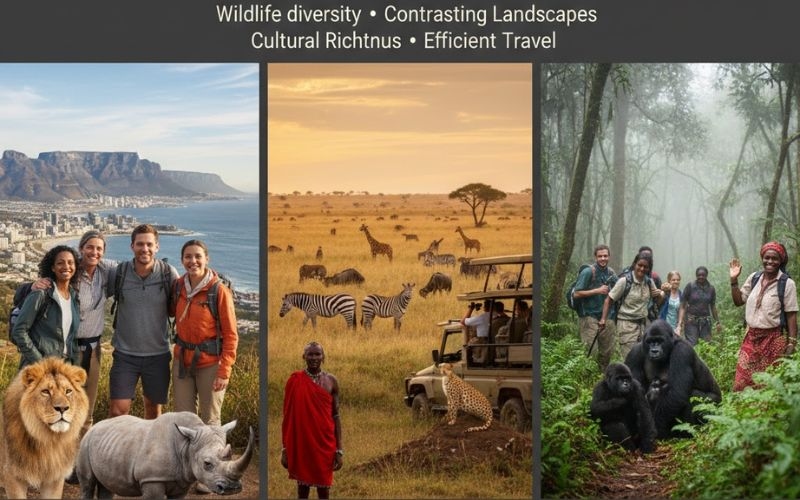
Wildlife diversity: Big Five in South Africa, classic savanna game in Kenya’s Masai Mara, and mountain gorillas in Uganda.
Landscapes that contrast: From Cape Town’s coastline to Kenya’s plains and Uganda’s misty forests.
Cultural richness: Explore township life in South Africa, Maasai traditions in Kenya, and local community trekking in Uganda.
Efficient travel: These countries are reasonably well connected, and visa processes can be optimized using the East African Tourist Visa (for Kenya + Uganda + Rwanda).
For a first safari, it's a balanced trip — not too rushed, but packed with unforgettable experiences.
What Types of Visa Are Needed for a 3-Country African Safari?
When traveling through South Africa, Kenya, and Uganda, you’ll need to plan your entry documents carefully.
South Africa: Depending on your nationality, you may need a visa before arrival. Check the South African consulate site for up-to-date requirements.
Kenya & Uganda (plus potentially Rwanda): Here’s where the East African Tourist Visa comes in as a useful option.
East Africa Tourist Visa: Can It Help You Visit All Safari Locations?
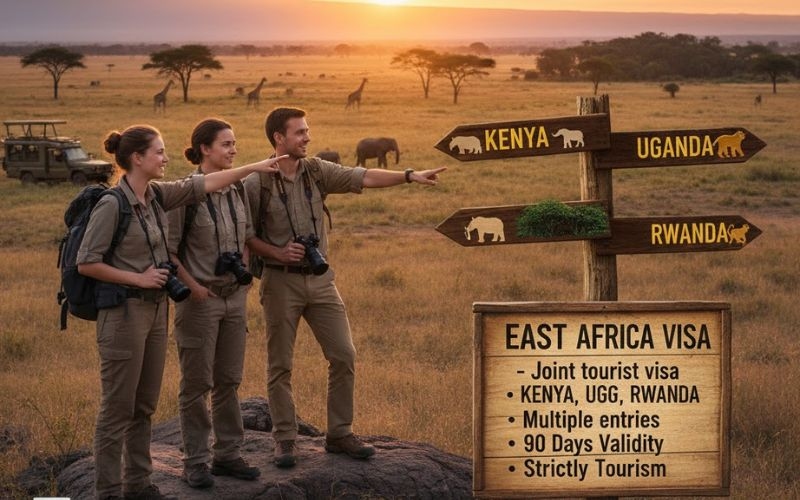
The East African Tourist Visa is a game-changer if you plan to visit both Kenya and Uganda (and even Rwanda). But it does not include South Africa. Here's how it works:
What Is the East African Tourist Visa?
It’s a joint tourist visa for Kenya, Uganda, and Rwanda.
It permits multiple entries between those three countries.
Validity: 90 days from the date of first entry.
Fee: (non-refundable).
Cannot be extended.
Not for work — strictly tourism.
Because of its flexibility, the EATV is a powerful tool for first-timers planning to move between East African safari countries.
Travel Documents & Safety Essentials for Multi-Country Safaris
Beyond visas, a few key documents and safety precautions can make your trip much more relaxed:
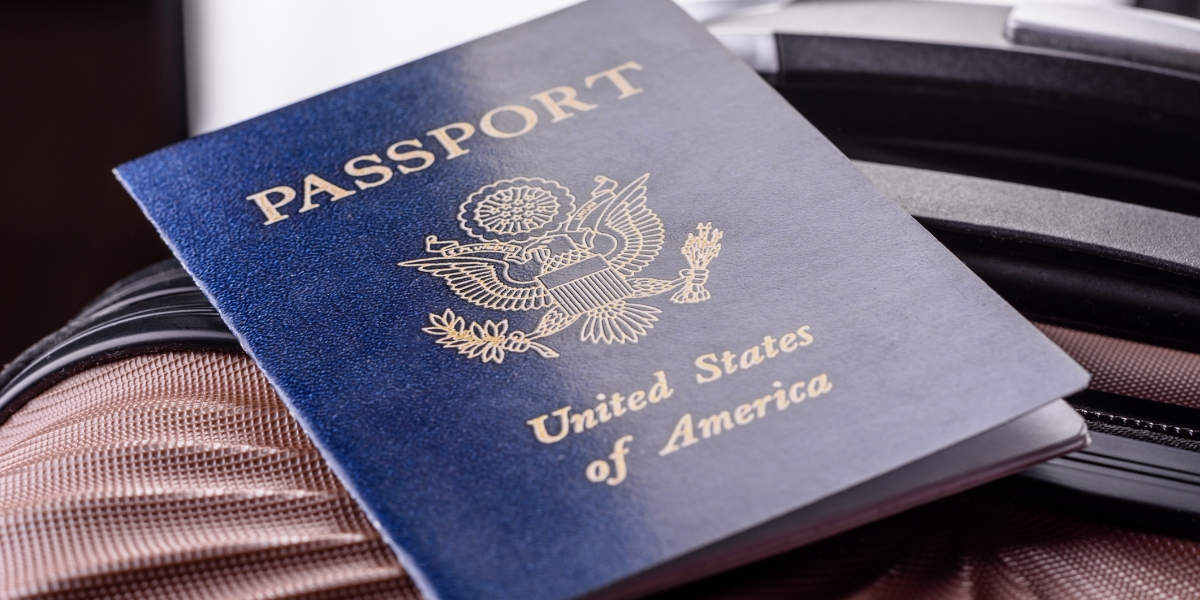
Passport & Copies: Carry your passport, plus printed and digital copies.
Travel Itinerary: Have your trip plan, accommodation bookings, and flight details.
Vaccination Certificate: Yellow fever proof is often a must.
Travel Insurance: Make sure your policy covers multi-country travel, wildlife drives, and trekking.
Health Kit: Include first aid, insect repellent, sunscreen, and any prescription medications.
Emergency Info: Local embassy contacts, tourist help lines, and guides/trip leader numbers.
What to Expect on a 7-Day South Africa, Kenya & Uganda Safari Adventure
Here’s how your adventure could flow:
Day 1–2 (South Africa): Arrive in Cape Town or Johannesburg, soak up scenery, history, and city life.
Day 3–4 (Kenya): Fly to Masai Mara, go on game drives, maybe stay in a tented camp, and interact with Maasai culture.
Day 5–7 (Uganda): Head to Bwindi Impenetrable Forest or Mgahinga for gorilla trekking, and visit local villages.
You’ll enjoy sunrise drives, prime wildlife viewing, cultural interactions, and the raw thrill of trekking to see gorillas — all in a week.
Day 1–2: Start Your Adventure in South Africa – Cape Town or Johannesburg
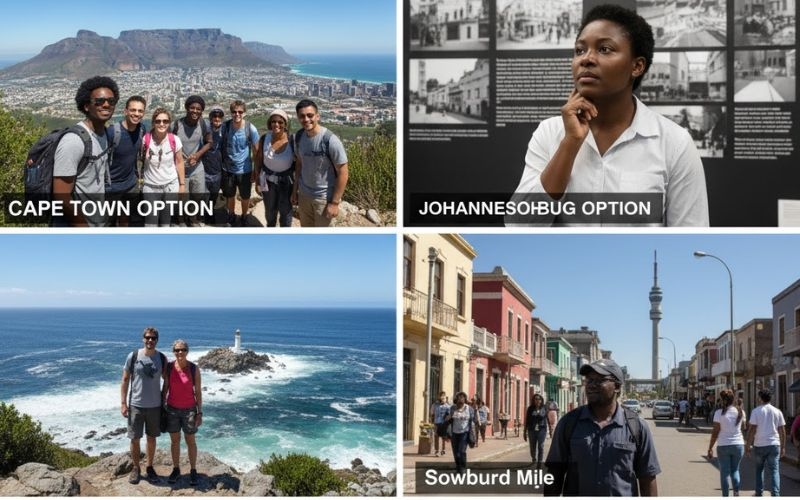
Your safari journey begins in South Africa secret wonder, the perfect introduction to adventure before heading deeper into the wild.
Cape Town Option
Table Mountain: Hike or take the cable car for stunning views.
Cape Peninsula: Drive out to Cape Point and see the rugged coastline.
Boulders Beach: Visit the charming African penguin colony.
Winelands: Taste wine in Stellenbosch, Franschhoek, or Paarl.
Johannesburg Option
Apartheid Museum: A powerful, deeply educational experience.
Soweto: Guided tours through this historic township.
Maboneng Precinct: An artsy, vibrant neighborhood with street art, local markets, and nightlife.
Top Things to Do in South Africa on Your First Safari Days
While you're in South Africa, make the most of these activities:
Reserve Safari Drive: Book a half-day or full-day game drive in reserves near Cape Town or Johannesburg to meet some of the Big Five.
Culinary Exploration: Try South African favorites like braai (barbecue), bobotie (a Cape Malay dish), or seafood along the coast.
Scenic Drives: Route along Chapman’s Peak, the Cape Peninsula, or even out to vineyards.
Cultural Tours: Visit local townships, learn about history, and engage with South African heritage.
Day 3–4: Kenya’s Wildlife Kingdom – Masai Mara Safari Plan
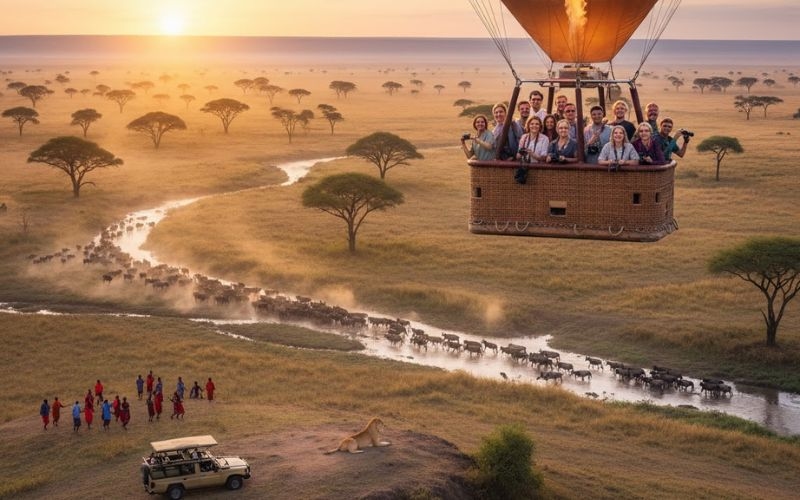
By Day 3, you fly to Kenya (likely Nairobi) and then head to the Masai Mara, which is arguably the most iconic safari destination in Africa.
Why Masai Mara?
It’s home to abundant wildlife — lions, cheetahs, elephants, and more.
The landscape is classic African savanna, perfect for those first-game-drive moments.
If you time it right, you may witness the Great Migration, when hundreds of thousands of wildebeest and zebras cross the Mara River.
Key Activities
Game Drives: Morning and evening drives are best for predator sightings.
Maasai Village Visit: Meet Maasai people, learn about their culture, and watch traditional dancing.
Hot-Air Balloon Ride: Float over the Mara plains at sunrise — absolutely magical.
Day 5–7: Uganda – Gorilla Trekking & Cultural Experiences

Uganda welcomes you with lush forests and some of the most emotional wildlife encounters you’ll ever experience. Gorilla Trekking here is truly unforgettable.
Gorilla Trekking
Trek to see mountain gorillas in Bwindi Impenetrable National Park or Mgahinga Gorilla National Park.
Expect a hike through dense, steep forest; guides help you navigate safely and respectfully.
You’ll usually spend an hour with a gorilla family (as permitted by park authorities).
Local Culture & Nature
Visit Batwa communities or local villages to learn about forest life and traditions.
Explore the crater lakes or take nature walks.
Spend time at a local lodge or eco-camp for an immersive experience.
Best Travel Route Between South Africa → Kenya → Uganda

Here’s a practical sequence to make your trip smoother:
Start in South Africa: Arrive in Cape Town or Johannesburg.
Fly to Kenya: Nairobi is the most common gateway.
Fly to Uganda: Entebbe International Airport connects easily to both safari hubs and city centers.
This routing minimizes long layovers and uses regional airline networks efficiently.
Best Time to Visit for a Combined Kenya–Uganda–South Africa Safari
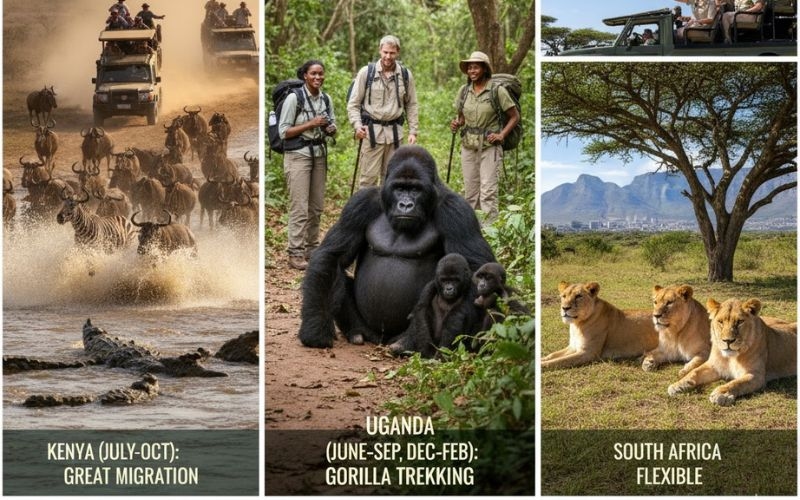
Timing is critical to maximize wildlife viewing and comfort:
Kenya (Masai Mara): The Great Migration typically peaks July–October when animal movements and river crossings are most dramatic.
Uganda (Gorilla Trekking): Best during the dry seasons, roughly June–September and December–February, when trails are less slippery.
South Africa: More flexible, but combining with Kenya/Uganda’s optimal months helps you avoid extreme weather or crowds.
June to October is the best time to Visit in South Africa and also ideal for exploring Kenya and Uganda, offering amazing wildlife sightings and great conditions for gorilla trekking.
Where to See the Big Five in Each Country
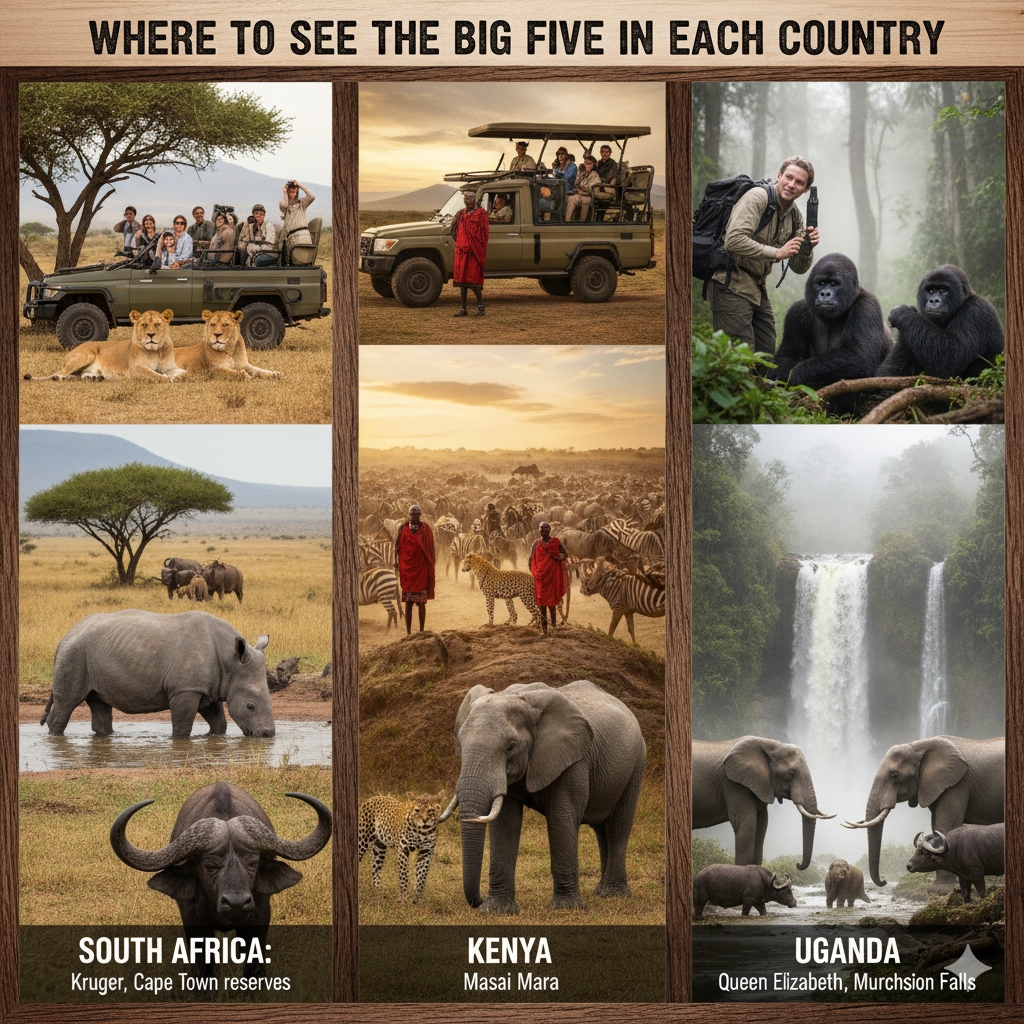
South Africa: Parks like Kruger or reserves near Cape Town can offer lion, elephant, buffalo, rhino, and sometimes leopard.
Kenya: The Masai Mara is ideal for Big Five sightings.
Uganda: While gorillas are the highlight, parks like Queen Elizabeth and Murchison Falls offer elephants, buffalo, buffalo, and occasionally lions.
Cultural Experiences to Add in South Africa, Kenya & Uganda

South Africa
Join a township tour (e.g., Soweto) to understand history, art, and life.
Try local cuisine workshops — learn to cook traditional dishes.
Visit art galleries and craft markets — Cape Town is full of creative energy.
Kenya
Stay in a Maasai boma (traditional home) to see how Maasai people live.
Attend dance performances or community workshops.
Explore Nairobi’s markets for crafts, jewelry, and local goods.
Uganda
Trek to Batwa pygmy communities to learn about forest traditions.
Visit eco-lodges and participate in local conservation projects.
Enjoy cultural music, dance, and storytelling evenings in rural villages.
Kenya’s Great Migration Viewing Spots

If you’re visiting during migration season, these are hot spots:
Mara River: Famous for dramatic river crossings when herds risk all to cross.
Talek River & Sand River: Also witness wildebeest movement depending on rain and grazing conditions.
Staying in conservancies (private reserves) gives more intimate wildlife experiences, away from crowded lodges.
Hot Air Balloon Safari in Kenya – Worth It?

Yes — absolutely. It’s one of the most magical ways to see the Mara:
You’ll float at dawn, just above the plains, watching herds below.
Wildlife looks different from the air and is often more spread out.
Some tours include a champagne-style breakfast after landing in the bush.
It’s more expensive than a game drive, but for many first-timers, it’s a “must-do.”
Additional Wildlife & Adventure Extras
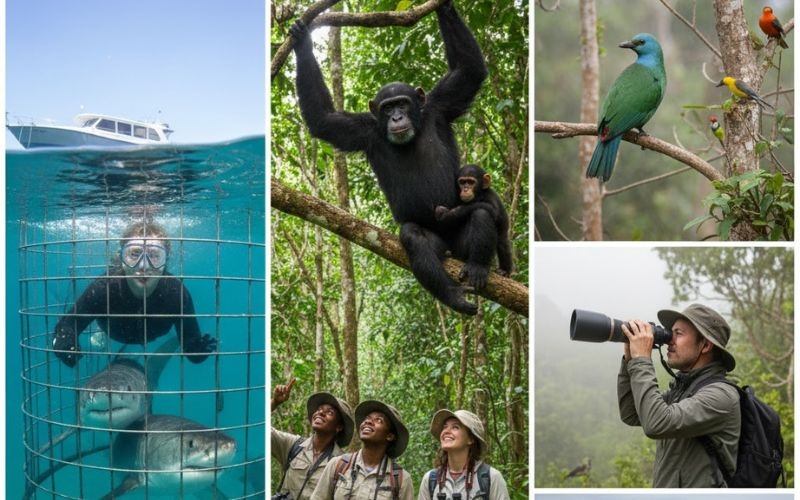
Cage Diving with Sharks in South Africa: For adrenaline lovers, head to places like Gansbaai for shark cage experiences.
Chimpanzee Trekking in Uganda: In forests like Kibale, you can trek to find chimps — less crowded than gorilla treks but deeply rewarding.
Bird Watching & Forest Walks: Uganda is excellent for birding; South Africa has rich biodiversity too.
Multi-Destination Travel Insurance for African Safaris
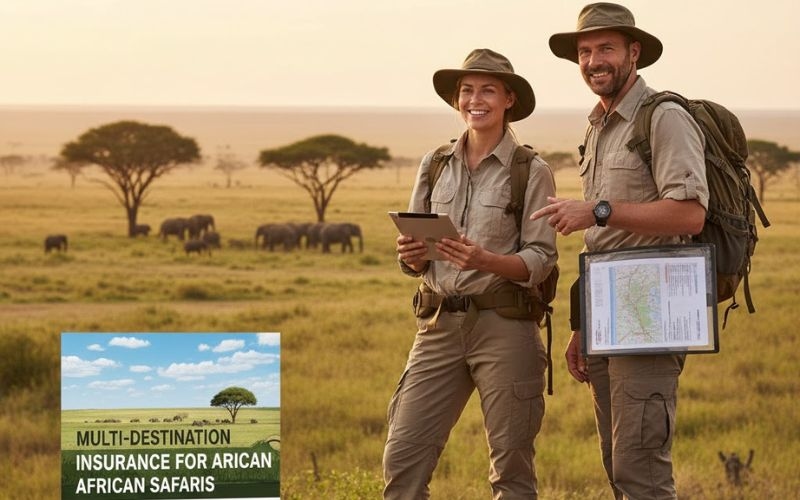
Choose a plan that covers safari drives, trekking, and medical evacuation.
Confirm that your insurance works across all three countries.
Carry print and digital copies of your policy.
Make sure the insurer knows you’ll be doing “adventure travel” — many standard policies exclude wildlife risk activities.
Using Mobile Internet & SIM Cards During Your Safari
Staying connected across South Africa, Kenya, and Uganda is easier than many travelers expect. Whether you're from Europe, North America, Asia, the Middle East, South America, Australia, or anywhere else, you’ll have several options:
1. Buy a Local SIM Card in Each Country
Most global travelers prefer picking up a local prepaid SIM upon arrival at the airport.
South Africa
Major networks: Vodacom, MTN, Telkom
Strong coverage in cities; moderate in remote safari areas
SIMs are inexpensive and sold at airports, malls, and kiosks
Kenya
Major networks: Safaricom, Airtel
Safaricom generally has the widest coverage, including safari zones
SIMs easily available at Nairobi airports & official shops
Uganda
Major networks: MTN, Airtel Uganda
Good coverage around towns; mixed in remote, mountainous forest regions
SIMs available at Entebbe airport and cities
Final Thoughts
Starting with a first safari that spans South Africa, Kenya, and Uganda is one of the best ways to fall in love with Africa. You’ll get wildlife, culture, drama, and heart-stopping moments. The East African Tourist Visa makes the Kenya–Uganda leg especially smooth, but careful planning is key — from visas to permits to insurance.
With thoughtful preparation, this trip won’t just be a vacation — it will become a deeply personal journey that stays with you forever.
Frequently Asked Questions (FAQs)
Q1: Do I need a visa for each of the three countries?
For Kenya, Uganda & Rwanda, you can use the East African Tourist Visa, which covers all three. For South Africa, you’ll likely need a separate entry visa (depending on your nationality).
Q2: How long is the East African Tourist Visa valid?
It is valid for 90 days from the first entry. It is a multiple-entry visa within those three countries.
Q3: How long does it take to get the East African Tourist Visa?
The approval timeline varies, but for Uganda, for example, the eVisa portal often processes in 2–5 business days. It’s wise to apply at least 10 working days in advance to avoid last-minute issues.
Q4: What if I already have a visa for Kenya or Uganda?
If you already have a valid tourist visa for one country, you might not need the East African Tourist Visa — but it depends on your travel plan. Be careful: the East African Tourist Visa requires you to enter via the issuing country first.
Q5: Why is the yellow fever vaccination required?
Many countries in East Africa, including Uganda, require proof of yellow fever vaccination for entry. It’s a common public health requirement for visa issuance.
Q6: Can I extend the East African Tourist Visa?
No — the visa cannot be extended. Plan your itinerary to complete your travel within the 90-day validity.
Q7: Is the hot-air balloon safari in Kenya worth the money?
For many first-time safari-goers, yes — it’s a once-in-a-lifetime experience, especially at dawn with wildlife views and potentially a bush breakfast.
